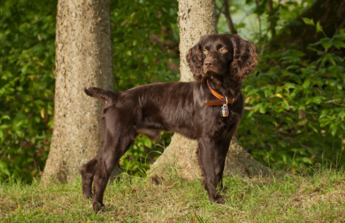With his handsome and abundant coat, the grooming requirements of the Portuguese Water Dog are above average. Regular grooming is essential to keep his coat in good condition, including brushing, bathing, haircut, nail trim, and ear cleaning. You can let the coat grow long or clip it short.
Expect to groom (do it yourself or better yet, hire a professional groomer) your dog every six to eight weeks, especially if you wish to keep the coat trimmed short. Regular brushing several times a week with a pin or slicker brush is necessary if you let the coat grow out. Regular tooth brushing with a soft toothbrush and doggie toothpaste keep the teeth and gums healthy.
The rest is basic care. Trim the nails as needed, usually every week or two. Brush the teeth frequently with a vet-approved pet toothpaste for good overall health and fresh breath.
Exercise is a necessity rather than a luxury with the Portuguese Water Dog. It was bred to work many a long hour working hard, and even though it may be a house pet, it still needs to get its exercise in.
If you don’t provide your poochwith enough, your dog will use this energy toward destructive purposes. Besides, you’ll find that your Portuguese Water Dog is much happier when it gets the exercise it needs. Just a few of the exercise options include swimming, walking, and running. These dogsneed at least an hour’s worth of exercise each day.
The Portuguese Water Dog needs the same nutrient sources that are similar to those found in the breeds native environment, as well as the proper balance of protein, carbohydrates, fatty acids, vitamins and minerals. Just a few of the foods this dog likes are fish and sweet potatoes.
Any diet should be appropriate to the dog’s age (puppy, adult, or senior). Some dogs are prone to gettingoverweight, so watch your dog’s calorie consumption and weight level.Treatscan be an important aid in training, but giving too many can cause obesity.
Learn about whichhuman foodsare safe for dogs, and which are not. Check with your vet if you have any concerns about your dog’s weight or diet.Clean, fresh water should be available at all times.
The Portuguese Water Dog is an exceptionally healthy breed. If you take good care of your dogwith exercise, regular preventative vet checkups, and feed your pooch a well-balanced and nutritious diet, your dog should live a long life.
One of the few issues to be aware of is hip dysplasia, which is common in this breed due to its size. This can lead to complications and moderate to severe lameness later in life. Another illness that is known to affect this breed is GM-1 Storage Disease. This lethal condition damages the nerves and ultimately leads to death. There is no way to screen puppies for this condition.
The Portuguese Water Dog is very intelligent and responds well to obedience training. He is demanding of attention and human contact, and greets friends and family with unbridled enthusiasm.
The breed often thinks independently, and a Portie may sometimes challenge his owner’s will. He requires positive training methods as well as daily mental and physical exercise. Porties can sometimes be too exuberant for families with very young children.











